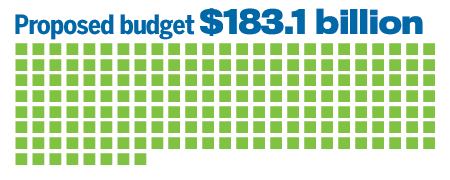What Trump’s First Budget Means for All 17 Departments
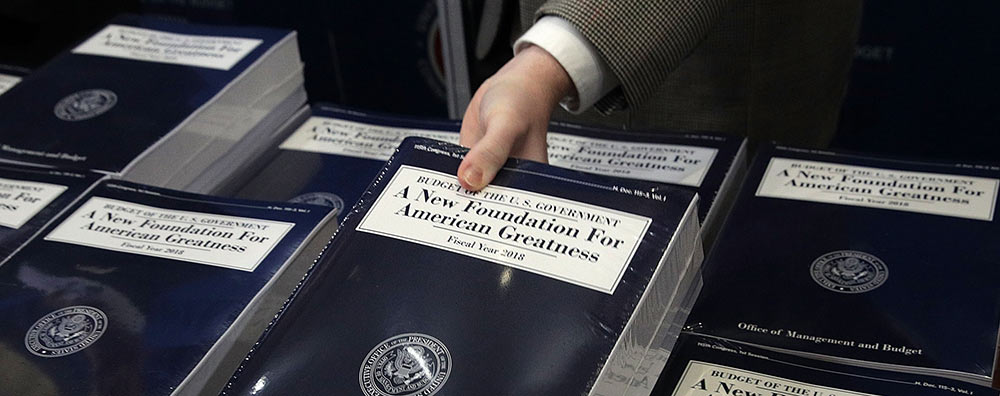
President Donald Trump’s proposal would balance the federal budget within 10 years, achieved through deep spending cuts and rosy predictions for economic growth and revenues.
And it’s getting an icy reception on Capitol Hill.
The proposal was harshly criticized by Democrats, and even some Republican allies rebuked it for politically unrealistic cuts to the social safety net and a broad swath of other domestic programs.
See how every department would be affected and what that would mean for its bottom line:
Agriculture 5%
The proposed budget would limit subsidies to farmers, including a cut in government help for purchasing crop insurance. Crop insurance is overwhelmingly popular program with farm-state senators in both parties, and previous farm bills have only increased spending. The budget would also limit spending on environmentally-friendly conservation programs and some rural development dollars that help small towns build infrastructure.
Trump isn’t the first president to try to limit farm subsidies. Presidents Barack Obama and George W. Bush also proposed major reductions, but farm-state lawmakers have always kept them going. The Republican chairmen of the Senate and House agriculture committees both said Tuesday they oppose Trump’s proposed cuts.

Commerce 15.4%
The budget would eliminate three economic development agencies and several grant programs aimed at preserving the environment and dealing with climate change. The Minority Business Development Agency, the Economic Development Administration and the Manufacturing Extension Partnership would be eliminated.
The budget would also eliminate several grant programs run by the National Oceanic and Atmospheric Administration: the Sea Grant, the National Estuarine Research Reserve System, Coastal Zone Management Grants, the Office of Education and the Pacific Coastal Salmon Recovery Fund.

Defense 3.3%
The Pentagon’s proposed 2018 budget would fund increases of almost 43,000 in the size of the active duty military and 13,000 in the Reserves. It provides troops a 2.1 percent pay raise, adds F/A-18 fighter jets and seeks a new round of base closures, which Congress routinely rejects.
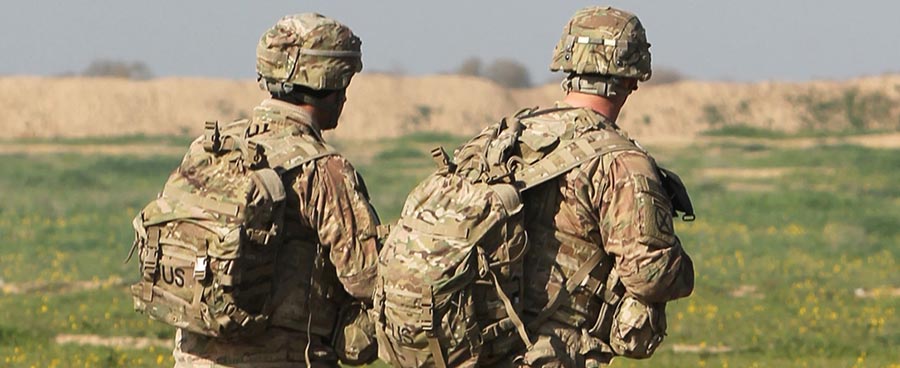
It also increases the amount of money used for training Afghan forces and conducting counterterror operations in Afghanistan.

Education 46.9%
Eliminates after-school and teacher training programs, ends subsidized federal student loans and loan forgiveness programs for public servants, funds year-round Pell grants and expands funding for school choice for low-income students.

Energy 5.7%
Trump’s budget would hike spending for the National Nuclear Security Administration, which is responsible for maintaining the nuclear stockpile, while cutting other energy spending. The budget seeks $120 million to revive the mothballed Yucca Mountain nuclear waste repository (pictured below), which is hugely unpopular in Nevada and was largely stopped by the efforts of former Democratic Sen. Harry Reid.
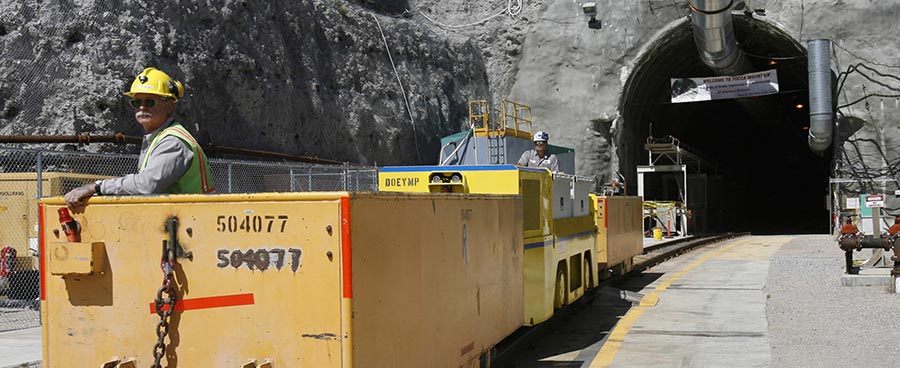
The budget also slashes $700 million from an Energy Department office that promotes energy efficiency and renewable energy and eliminates the Office of Science and the Advanced Research Projects Agency-Energy (ARPA-E), which supports research into new energy technologies.

Environmental Protection Agency 31%
The budget cuts EPA by nearly one-third, eliminating more than 3,800 jobs while imposing dramatic cuts to clean air and water programs. Adjusted for inflation, the proposed budget would represent the nation’s lowest funding for environmental protection since the mid-1970s. The Superfund pollution cleanup program would be cut by $330 million, to $762 million.

Health and Human Services 1.3%
The budget initiates deep cuts to health insurance programs for people with modest incomes, including coverage for children. Those cuts would go beyond the House GOP bill that repeals much of the Affordable Care Act, also known as “Obamacare,” and limits future federal financing for Medicaid.
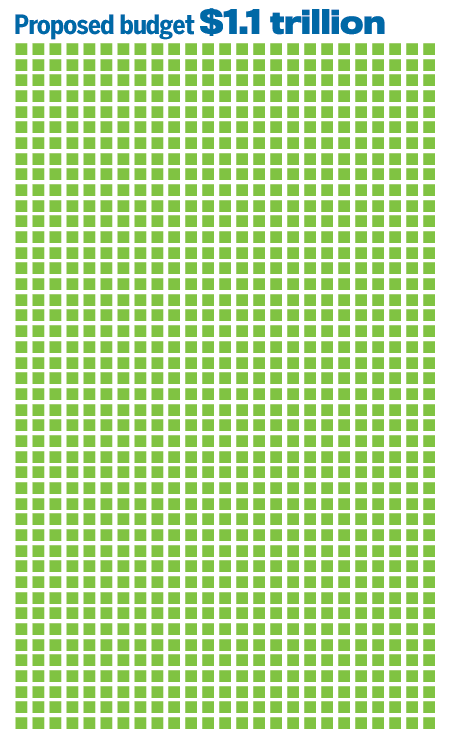
Homeland Security 3.2%
The budget asks Congress for $2.6 billion for border security that would include a down payment for Trump’s long-promised wall and increased technology along the U.S.-Mexican border. The budget calls for $314 million to hire 500 new Border Patrol agents and 1,000 agents for Immigration and Customs Enforcement.

It also requests a $1.5 billion increase for ICE to arrest, detain and deport immigrants in the country illegally. The plan also proposes cutting about $667 million in grants administered by the Federal Emergency Management Agency. That includes proposed cuts to the Urban Area Security Initiative and eliminating the Transportation Security Administration’s law enforcement grants.

Housing and Urban Development 22.9%
The budget would eliminate HUD’s Community Development Block Grant program, a $3 billion effort that funds local improvement projects, affordable housing construction and other social supports like meals for seniors and enrichment programs for low-income children.
The budget proposal says the program is not well targeted to poor populations and hasn’t showed measurable impact on communities. The administration’s budget also seeks to cut costs to the department’s rental assistance programs — a $2 billion decrease to $35.2 billion. Rental assistance programs comprise about 80 percent of the agency’s total funding.

Interior 9.2%
The budget calls for opening Alaska’s Arctic National Wildlife Refuge to oil and gas drilling, where it is now prohibited, while eliminating offshore oil revenues used by Gulf Coast states to restore disappearing shorelines.
Arctic drilling, a contentious issue that would require congressional approval, would generate an estimated $400 million a year in tax revenues by 2022, according to the White House. Elimination of revenue-sharing to the four Gulf Coast states — Alabama, Louisiana, Mississippi and Texas — would generate $1.6 billion over the next five years, the document says. The proposal also includes money for seismic surveys to provide data for possible offshore drilling in the Atlantic Ocean where it is now barred.

Justice 19.1%
The budget adds $26 million for 300 new assistant U.S. attorneys to fight gangs, violent crime and illegal immigration. Attorney General Jeff Sessions has identified those areas as his top priorities. The plan calls for 230 of these prosecutors to be stationed in yet-to-be-named cities deemed hot spots for violence.
A budget that puts #AmericaFirst must make safety its no. 1 priority—without safety there can be no prosperity: https://t.co/9lxx1iQo7m
— Donald J. Trump (@realDonaldTrump) March 16, 2017
Another 70 will be assigned to border states, focusing on those who enter and re-enter the country illegally after deportation, as well as document-fraud, human smuggling, drug trafficking and other immigration-related offenses.

Labor 3.3%
Trump is proposing cuts in job training programs including $434 million for the Senior Community Service Employment Program, $238 million by closing Job Corps centers, and $68 million for the Bureau of International Labor Affairs. He is proposing $90 million more for apprenticeships that result in jobs and a parental leave program of six weeks.

NASA 1.2%
The budget cancels five planned missions to observe Earth and monitor climate change, saving $191 million. It eliminates an Obama-era mission to send astronauts to an asteroid. It also slashes NASA education spending by two-thirds and makes smaller cuts to exploration and space operations, along with increases in spending to explore other planets.

State 29%
Eliminates funding for the U.N. children’s agency, UNICEF, as part of a $780 million cut to international organizations. Also eliminates $1.6 billion in funding for climate change and slashes assistance for refugees and global health. That includes $222 million cut in an international fund for fighting AIDS, tuberculosis and malaria. Proposal also ends $523 million for international family planning programs.

Transportation 2.2%
Trump proposes that the government pay $200 billion toward the $1 trillion cost of improving the nation’s infrastructure — rebuilding aging roads, bridges, water systems and more. Private investments would pay the rest, under his plan. He’s also suggesting cutting grants to Amtrak long distance services by $630 million and reducing the Highway Trust Fund by $95 billion over a decade.

Treasury 6.7%
Treasury oversees the Internal Revenue Service and the agency responsible for managing the government’s payment systems. The IRS would see a 2.1 percent budget cut, but says it will continue to seek less costly ways of delivering taxpayer services. Trump’s budget would provide increased investment for cybersecurity as well as implementing the sanctions program to combat terrorist financing. The budget would also seek initial funding to replace the aging Washington facility for the Bureau of Engraving and Printing that produces the nation’s paper currency.

Veterans affairs 3.7%
The budget proposes a $4.3 billion increase in discretionary spending, mostly to pay for medical care at more than 1,200 VA facilities nationwide serving about 9 million enrolled veterans. That’s a 5.8 percent increase as the Department of Veterans Affairs expands its network to include more private health providers.
I will take care of the Veterans who have served this country so bravely.#ThankAVet Video: https://t.co/WH9GSeSH29 pic.twitter.com/WMR7jnmsyz
— Donald J. Trump (@realDonaldTrump) January 29, 2016
The budget also calls for $2.9 billion in mandatory budget authority for 2018 and $3.5 billion in 2019 to pay for expansion of the Veterans Choice private-sector program. To help pay for rising costs from that program, the VA would cap the amount of educational benefits veterans receive under the GI bill to roughly $21,000 a year and halt “individual unemployability” benefit payments to out-of-work disabled veterans once they reach retirement age.
